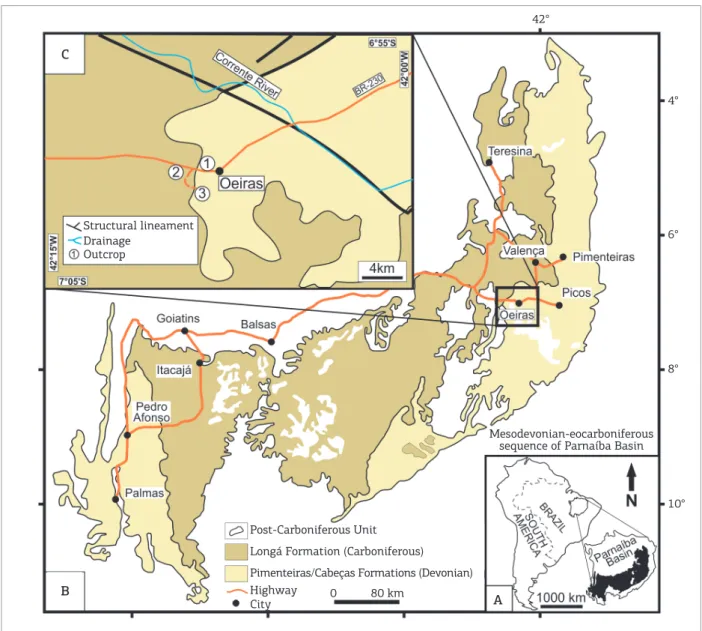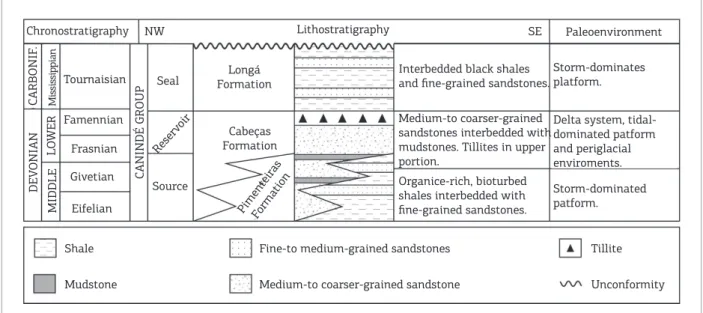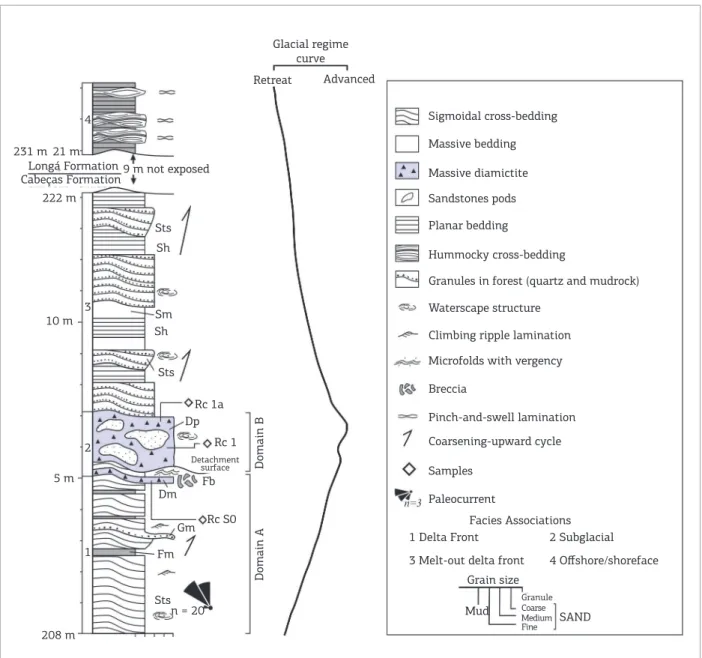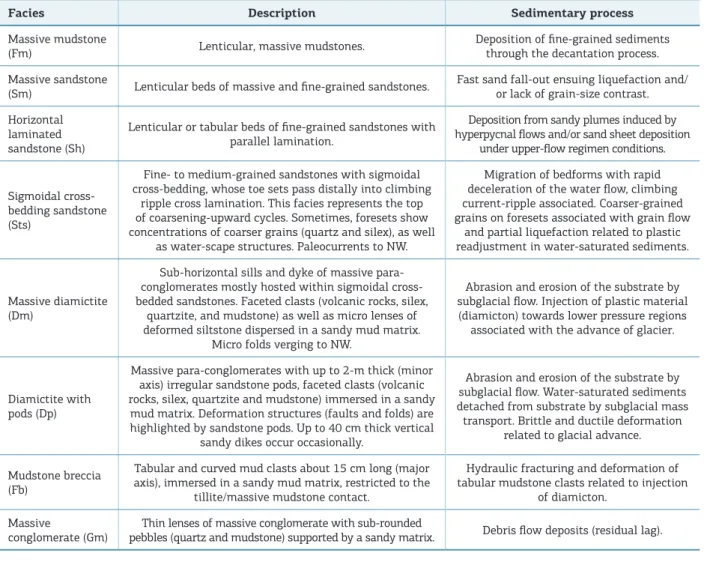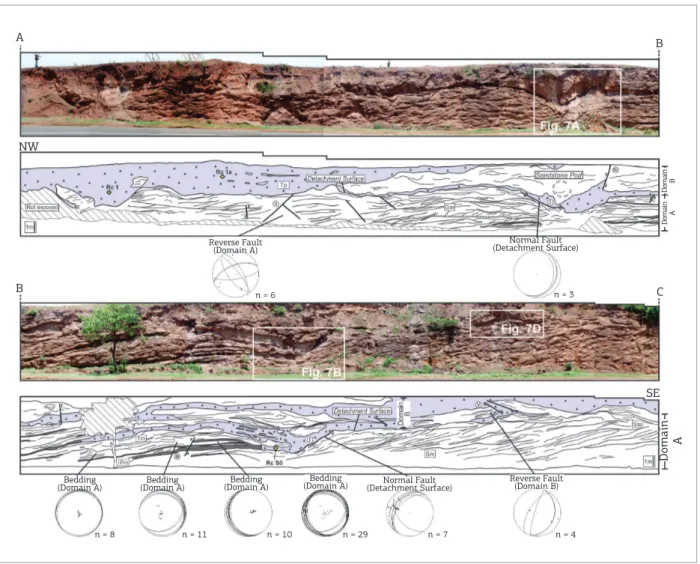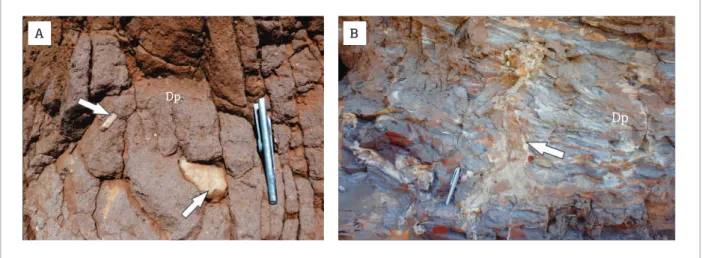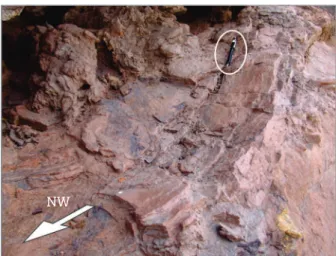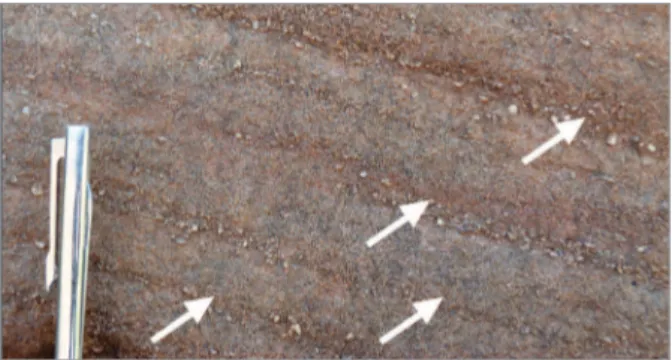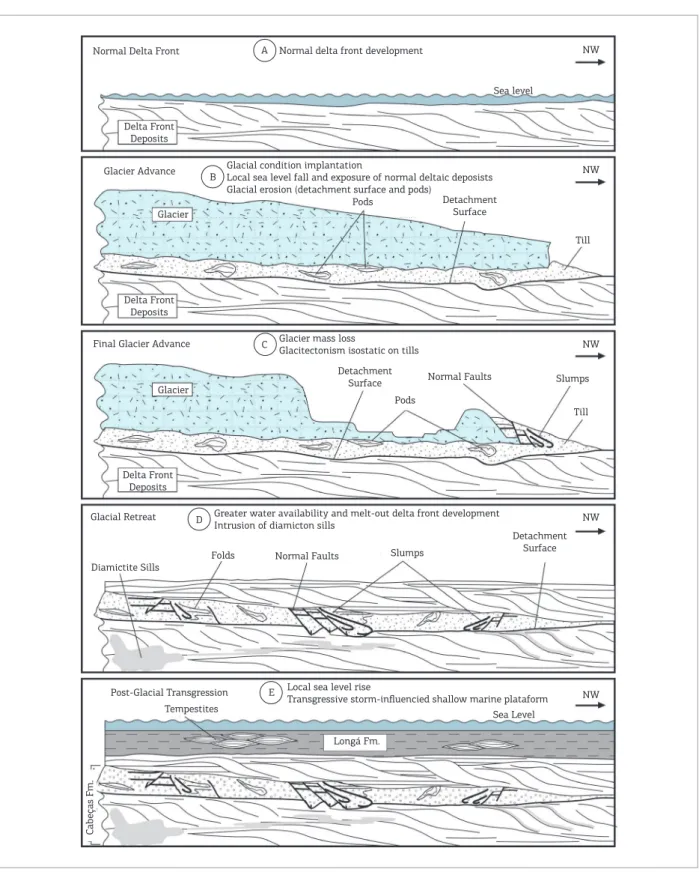1Programa de Pós-graduação em Geologia e Geoquímica, Instituto de Geociências, Universidade Federal do Pará – UFPA, Belém (PA), Brasil. E-mails: rbarbosa@ufpa.br; anogueira@ufpa.br
2Instituto de Geociências, Faculdade de Geologia, Universidade Federal do Pará – UFPA, Belém (PA), Brasil. E-mail: fabiodomingos@hotmail.com
*Corresponding author.
Manuscript ID: 30147. Received: 08/03/2014. Approved: 06/10/2015. ABSTRACT: Glaciotectonic features studied in the siliciclastic de-posits of Cabeças Formation, Upper Devonian, represent the irst evidence of Famennian glaciation in Southeastern Parnaíba Basin, Brazil. Outcrop-based stratigraphic and facies analyses combined with geometric-structural studies of these deposits allowed deining three facies association (FA). hey represent the advance-retreat cy-cle of a glacier. here are: delta front facies association (FA1) com-posed of massive mudstone, sigmoidal, medium-grained sandstone with cross-bedding and massive conglomerate organized in coarse-ning- and thickecoarse-ning-upward cycles; subglacial facies association (FA2) with massive, pebbly diamictite (sandstone, mudstone and volcanic pebbles) and deformational features, such as intraforma-tional breccia, clastic dikes and sills of diamictite, folds, thrust and normal faults, sandstone pods and detachment surface; and mel-t-out delta front facies associations (FA3), which include massive or bedded (sigmoidal cross-bedding or parallel bedding) sandstones. hree depositional phases can be indicated to Cabeças Formation: installation of a delta system (FA1) supplied by uplifted areas in the Southeastern border of the basin; coastal glacier advance causing tangential substrate shearing and erosion (FA1) in the subglacial zone (FA2), thus developing detachment surface, disruption and rotation of sand beds or pods immersed in a diamicton; and retreat of glaciers accompanied by relative sea level-rise, installation of a high-energy melt-out delta (FA3) and unloading due to ice retreat that generates normal faults, mass landslide, folding and injection dykes and sills. he continuous sea-level rise led to the deposition of ine-grained strata of Longá Formation in the ofshore/shoreface transition in the Early Carboniferous.
KEYWORDS: Cabeças Formation; glaciotectonic structures; Famennian glaciation; Parnaíba Basin.
RESUMO: Estruturas glaciotectônicas estudadas nos depósitos silici-clásticos da Formação Cabeças do Devoniano Superior representam a primeira evidência da glaciação fameniana na borda Sudeste da Bacia do Parnaíba, no Norte do Brasil. A análise estratigráica e faciológica em combinação com estudos geométrico-estruturais desses depósitos permiti-ram deinir três associações de fácies (AF) representativas de um ciclo de avanço-recuo de geleira, a saber: associação de fácies de frente deltaica (AF1), composta por pelitos maciços, arenitos inos a médios com estrati-icação cruzada sigmoidal e conglomerado maciço, organizados em ciclos grano- e estrato-crescentes; associação de fácies subglaciais (AF2), con-sistindo de diamictitos maciços seixosos (seixos de arenito, pelito e rochas vulcânicas) e feições deformacionais, tais como brechas intraformacionais, sills e diques clásticos de diamictitos, dobras, falhas normais e de cavalga-mento, pods de arenitos e plano de descolamento; e associação de fácies de frente deltaica de degelo (AF3), constituída por arenitos maciços ou lam-inados (estratiicação plano-paralela e/ou cruzada sigmoidal), localmente com deformações sin-sedimentares. Três fases deposicionais são indicadas para os depósitos da Formação Cabeças: instalação de um sistema deltaico (AF1), advindo de áreas soerguidas do Sudeste da bacia; avanço de geleiras costeiras, que causa cisalhamento tangencial e erosão do substrato (AF1), em zona subglacial (AF2), desenvolvendo superfície de descolamento, rompimento e rotação de camadas arenosas ou pods imersos em diamicton; e recuo das geleiras acompanhado pelo aumento relativo do nível do mar, pela instalação de um sistema deltaico de degelo de alta energia (AF3) e processos de alívio de pressão que geram falhas normais, escorregamento de massa, dobras e injeções de diques e sills. O aumento contínuo do nível do mar levou à deposição dos sedimentos inos da Formação Longá na zona de transição ofshore/shoreface no início do Carbonífero.
PALAVRAS-CHAVE: Formação Cabeças; estruturas glaciotectônicas; glaciação fameniana; Bacia do Parnaíba.
Famennian glaciation in the eastern side of
Parnaíba Basin, Brazil: evidence of advance
and retreat of glacier in Cabeças Formation
A glaciação fameniana na porção leste da Bacia do Parnaíba:
evidências do avanço e recuo de geleira na Formação Cabeças
Roberto Cesar de Mendonça Barbosa1*, Afonso César Rodrigues Nogueira1,
Fábio Henrique Garcia Domingos2
INTRODUCTION
Gondwana glacigenic successions have been the focus of several recent stratigraphic studies, mainly due to their poten-tial as possible petroleum systems. One of the key reasons is the favorable condition for hydrocarbon generation that is associated with the presence of thick layers of transgressive post-glacial black shale, whereas sandstones, sandwiched by ine-grained glacio-marine facies, represent possible reservoir rocks (Vesely et al. 2007, Assine & Vesely 2008, Fielding et al. 2012). he glacial deposits in Western Gondwana are well preserved in the Paleozoic basins of South America (Cunha et al. 1994, Loboziak et al. 2000, Streel et al. 2000, Isaacson
et al. 2008). In Northern Brazil, Famennian rocks (374 to 359 Ma) of the Upper Cabeças Formation represent the main reservoir units of the Mesodevonian-Eocarboniferous petroleum system in the Parnaiba Basin (Figs. 1 and 2). Tillites with faceted clasts and rare striated pavements are yet the only basis to support a glacial inluence/nature of this unit (Caputo et al. 1971, Carozzi et al. 1973, Carozzi et al. 1975, Caputo 1985, Caputo & Crowell 1985, Grahn 1991, Grahn & Caputo 1992, Grahn & Paris 1992, Costa et al. 1994, Rocha-Campos et al.2000, Soares et al. 2005). On the other hand, glaciotectonic features result from the stress produced by the weight and movement of a glacier over underlying sediments, as well as the resulting features
42°
Structural lineament
Outcrop
0 80 km
City Highway
Pimenteiras/Cabeças Formations (Devonian) Longá Formation (Carboniferous) Post-Carboniferous Unit Drainage
4°
6°
8°
10°
Mesodevonian-eocarboniferous sequence of Parnaíba Basin
A B
C
Figure 1. Geological and location map of the studied area. (A) Exposure area of Mesodevonian-Eocarboniferous sequence (marked in black) in Parnaíba Basin. (B) Spatial distribution of Pimenteiras, Cabeças and Longá
formations. (C) Simpliied geology of Oeiras town, State of Piauí, with location of the studied outcrops (Modiied
are comparable to tectonic structures of shear belts, although generally much smaller, intraformational, and very shallow (Banham 1977, Nielsen 1988).
Within this context, this research includes the irst descrip-tion of deformed, pebbly tillites in Cabeças Formadescrip-tion in the Southeastern border of Parnaíba Basin, which represents the direct record of the Famennian Glaciation (Fig. 1). he out-crop-based stratigraphic and facies analysis combined with geometric-structural studies of the deposits allowed iden-tifying a glacier advance-retreat cycle and its related glaci-otectonic features, as well as to interpret it within a sedi-mentary evolution model. his work also contributes to understanding the role of glacial successions in the devel-opment of petroleum systems in the sedimentary basins of Western Gondwana.
GEOLOGICAL SETTING
he Parnaíba Basin is located in Northern Brazil and covers approximately 600,000 km2 (Fig. 1A). Its
sedimen-tary record is up to 3,500 m thick and is composed of siliciclastic and chemical rocks mainly of Paleozoic age, but it also includes Jurassic to Cretaceous volcanic rocks. Biostratigraphic data and regional unconformities recognized in seismic sections allowed dividing the sedimentary succes-sion of Parnaíba Basin into ive supersequences (Almeida & Carneiro 2004, Vaz et al. 2007): Silurian, Mesodevonian-Eocarboniferous, Neocarboniferous-Eotriassic, Jurassic and Cretaceous.
The discovery of oil and gas in the Mesodevonian-Eocarboniferous supersequence, which is characterized by siliciclastic deposits of Canindé Group, enlarges the demand for new geological information in an attempt to improve the petroleum system characterization. he Mesodevonian-Eocarboniferous petroleum system includes Pimenteiras, Cabeças and Longá formations (Fig. 2). Black shales of Pimenteiras Formation shows 2% of total organic carbon content and types II and III kerogens. Sandstones of Cabeças Formation comprise the reservoirs, whereas shales of Longá Formation constitutes the seal. he Cabeças Formation includes medium-to-coarse-grained sandstones interbedded with siltstones and shales, deposited in a tidal-and storm-in-luenced shelf environment (Góes & Feijó 1994, Vaz et al. 2007, Ponciano & Della Fávera 2009).
Kegel (1953) suggested the irst record of glacial strata in the upper portion of Cabeças Formation. Based on core data, this author identiied tillites with striated and faceted pebbles of quartz and crystalline rocks. Later, Carozzi (1980) and Caputo et al. (2008) studied striated pavements on sand-stones in the Eastern edge of Parnaíba Basin. heir indings are consistent with a glacier advance towards the Northwest part of the basin. Moore (1963) and Caputo (1985) analyzed outcrops of Cabeças Formation in the southwestern border of Parnaíba Basin and described foliated tillites with striated and faceted pebbles between layers of sandstones with mas-sive bedding and waterscape structures. hese investigators concluded that the glacier movement plastically deformed the sediments of Cabeças Formation, not afecting the older and younger Longá and Pimenteiras formations, respectively.
Chronostratigraphy
Tournaisian
CARBONIF
.
Mississippian
DEV
ONIAN
MIDDLE
Lithostratigraphy
Storm-dominated patform.
Delta system, tidal-dominated patform and periglacial enviroments. Storm-dominates platform.
Organice-rich, bioturbed shales interbedded with ine-grained sandstones. Medium-to coarser-grained sandstones interbedded with mudstones. Tillites in upper portion.
Interbedded black shales and ine-grained sandstones.
PimenteirasFormation
Cabeças Formation
Longá Formation
CANINDÉ GROUP
LO
WER
Eifelian
Shale
Mudstone
Fine-to medium-grained sandstones
Medium-to coarser-grained sandstone
Tillite
Unconformity Source
Seal
Reserv oir
Givetian Frasnian Famennian
NW SE Paleoenvironment
Figure 2. Simpliied stratigraphic column of the Mesodevonian-Eocarboniferous supersequence of Parnaíba Basin, represented by Canindé Group. The tillite of Cabeças Formation was dated as Late Famennian based on
Grahn et al. (2006) and Streel et al. (2013) inferred a Late Famennian age for these tillites based on the presence of miospores of LE (R. lepidophyta – H. explanatus) and LN (R. lepidophyta – V. nitidus) zones established to Western Europe.
METHODS
Facies and stratigraphic data (cf. Miall 1985 and 1988, Wizevic 1991, Arnot et al. 1997) were collected along cuts of BR-230 and secondary roads near Oeiras town, in the State of Piauí (Fig. 1C). he semiarid climate and predom-inance of savanna vegetation contribute to the excellent preservation of outcrops.
he structural analysis of the deformed facies was based on the concepts of Ramsay and Huber (1983, 1987) and Hancock (1994). his technique deals with linear and planar elements of the rocks, using geometric and kinematic analyzes. In this investigation, however, only a geometric analysis was performed to investigate the nature, spatial behavior and rela-tionships of overlapping structures. he spatial orientation of geological structures was measured with a geological compass and their attitudes were represented in stereographic projec-tion diagrams (network-Lambert Schmidt, lower hemisphere) using the OpenStereo software (version 7, Free Software). he analysis and interpretation of the glaciotectonic structures followed the proposal of Hart and Boulton (1991).
he diamictite matrix was characterized by counting the points of components under the optical microscope, with at least 300 points. he microfabric was described in ten rock slabs that were coated with a thin gold ilm and analyzed in a Scanning Electron Microscope (SEM), model 1450 – LED VP, in the laboratory of Museu Paraense Emílio Goeldi. Identiication of clay minerals was carried out through X-ray difraction (XRD) using the X’Pert Pro PANalytical dif-fractometer (40 kV and 40 mA), which was equipped with copper tube and graphite monochromator, in Universidade Federal do Pará.
GLACIO-DELTAIC DEPOSITS
Facies and stratigraphic analysis
he studied outcrops of Cabeças Formation are up to 14 m thick and 60 m wide. Lithologies include white-gray sandstones, diamictites, and purple-red mudstones. Eight sedimentary facies were identiied and represented in a com-posite columnar log (Fig. 3). he studied facies were grouped (Tab. 1) into three facies associations (FA) that comprised deposits of delta front (FA1), subglacial environment (FA2) and melt-out delta front (FA3).
Delta front (FA1)
his association is 5 m thick and consists of amalgam-ated, sigmoidal beds of fine-to medium-grained sand-stones, generally in contact with the subglacial deposits of FA2 (Fig. 3). he main facies of FA1 are massive mudstone (facies Fm), sigmoidal cross-bedded sandstone (facies Sts) and massive conglomerate (Gm) generally organized in coars-ening/thickening upward, meter-scale cycles (Tab. 1, Figs. 3 to 5). he sigmoidal lobes are internally composed of facies Sts with sigmoidal cross-bedding that passes laterally into subcritical climbing ripple cross-lamination. Locally occurs waterscape structure. Lenticular beds of the facies Gm and Fm are interbedded with sand lobes.
Interpretation
he sigmoidal lobes (facies Sts) indicate unidirectional migration of bedforms preferentially to the NW with rapid deceleration of water low. Climbing ripple cross-lamination (facies Sts) in the distal portions of the sigmoidal lobes is in agreement with the interpretation (Bhattacharya 2010). he presence of a waterscape structure is the evidence of partial liquefaction of unconsolidated, water-saturated sedi-ments (Lowe 1975, Owen 2003). he facies Sts and Fm are associated with low deceleration along the sigmoidal lobes, which are deined by combined bedload and suspended load processes in the proximal reaches (facies Sts) that progres-sively pass into clay fall out (facies Fm) in the distal reaches (Potter et al. 2005, Olariu & Bhattacharya 2006). Lenticular bodies of facies Gm suggest a limited contribution of sandy gravels associated with the deltaic lobes (Mutti et al. 2003, Olariu & Bhattacharya 2006). Sigmoidal sandstone bodies with complex geometry arranged as coarsening- and thick-ening-upward cycles are compatible with sand prograda-tion (delta front) into a low energy receiving basin, such as lakes (Bhattacharya 2010). Structures related to wave-and tidal-processes, as well as subaerial exposure, are absent and corroborate a calm receiving basin.
Subglacial deposits (FA2)
has sub-rounded to sub-angular grains, displaying low sphe-ricity and moldic porosity (Fig. 8). Eventually, the matrix is composed of siltstone and claystone, locally showing defor-mational structures similar to waterscape features and con-torted lamination. he primary components of the diamic-tite matrix are monocrystalline quartz grains, with undulose extinction (mean of 40%, Fig. 8A) and rare feldspar grains (<1%). K-feldspar is more common than plagioclase and both generally exhibit dissolution features. Rock fragments include siltstone and mudstone (maximum of 0.30% of the rock volume), however deformed siltstone lenses are also found in the matrix. Heavy minerals are represented mainly
by zircon and staurolite (maximum of 0.60% of the rock volume). he intergranular space is illed with silt-grained quartz, muscovite (0.90% average), and iron oxides/hydrox-ides (maximum of 49.70% of total volume). Clay minerals identiied by XRD include kaolinite, smectite, and illite. he secondary porosity of the diamictite matrix was characterized as moldic (0.90%), shrinkage (0.60%), and intragranular (0.30%). Moldic pores have sizes ranging from 130 μm to 450 μm and often exhibit tabular form (Fig. 8C). Shrinkage pores are irregular and developed in the siliciclastic matrix, but in the regions of contact between pores and framework they tend to follow the grain edge, partially isolating the
Granules in forest (quartz and mudrock)
Samples
Paleocurrent
Facies Associations 2 Subglacial 1 Delta Front
4 Offshore/shoreface 3 Melt-out delta front
Grain size
Mud SAND
Granule Coarse Medium Fine Pinch-and-swell lamination Coarsening-upward cycle Breccia
Microfolds with vergency Climbing ripple lamination Waterscape structure Hummocky cross-bedding Planar bedding
Sandstones pods Massive diamictite Massive bedding Sigmoidal cross-bedding Glacial regime
curve Advanced
231 m 21 m
9 m not exposed Longá Formation
Cabeças Formation 222 m
10 m
5 m
208 m 1 2 3
Sts
Sts Sh
Sh Sm
Dp
Domain B
Domain A
Rc 1a
Rc 1
Fb Dm
Gm
Fm
Sts n = 20
Rc S0
Detachment
surface 4
Retreat
Figure 3. Composite columnar log of Cabeças and Longá formations in Oeiras region with the advanced and retreat curve of the glacier and stratigraphic position of petrography samples. Delta deposits of Cabeças Formation are overlined by transgressive deposits of Longá Formation. Structural domains A and B represent glaciotectonic
matrix in the form of cutans (Fig. 8D). In general, shrink-age pores are isolated, up to 20 μm thick and 900 μm long. Intragranular pores are primarily found in feldspar grains and range from 15 to 35 μm.
he contact between FA1 sandstones and FA2 diamictite corresponds to a deformed zone characterized by an expres-sive subhorizontal plane herein interpreted as a detachment surface, which bounds not deformed and deformed strata (Figs. 3 and 4). his surface varies from subhorizontal to gentle dipping (25° to 30°). It is truncated by late NE-SW trending normal faults with low to moderate dips (21° to 42°) and subordinate reverse faults. Fault planes are high-lighted by up to 30 mm thick layer of rusted siltstone, which locally includes up to 6 cm wide, angular fragments of sandstone (Fig. 9). Some of the fault planes exhibit steps and striation plunging 40° towards NW (sector I, Fig. 7B) and kinematic indication of roof displacement to the NW.
Two structural domains bounded by the detachment sur-face were deined. Domain A includes structures in the FA1, whereas B comprises structures in the FA2 (Figs. 3 and 4).
he structures observed in Domain A are represented by normal and reverse faults, sub-horizontal sills (facies Dm), breccia (facies Fb), and open folds in the sedimentary bed-ding. Domain B is characterized by sandstone pods, reverse and normal faults (sector IV, Fig. 7A), disrupted beds (sec-tor V, Fig. 7D), and sub-vertical injection dikes illed with ine-to medium-grained sandstone crosscutting facies Dp (Fig. 6B). Locally, sandstone pods show a sigmoidal geom-etry that suggest rotation towards NW. his rotation was caused by the displacement of an adjacent NE-SW trend-ing, gently dipping (18° to 30°) reverse fault (sector IV) and a NE-SW trending, steeply dipping (60°-80°) normal fault, which crosscuts the detachment surface (sector I). hese faults deform the sandstone bedding of facies Dp, forming open folds in the facies Sts with inter limbs angles between 150° and 170° (sector III, Fig. 4B). Faults are oriented to NW-SE and ENE-WSW with moderate to high, up to 60° dip angles (sector II).
Synsedimentary structures such as folds, normal and reverse faults are indicated by undulated beds and displacement
Table 1. Facies and interpreted sedimentary processes of the Upper Devonian Cabeças Formation in Oeiras region
Facies Description Sedimentary process
Massive mudstone
(Fm) Lenticular, massive mudstones. Deposition of ine-grained sediments through the decantation process.
Massive sandstone
(Sm) Lenticular beds of massive and ine-grained sandstones. Fast sand fall-out ensuing liquefaction and/or lack of grain-size contrast.
Horizontal laminated sandstone (Sh)
Lenticular or tabular beds of ine-grained sandstones with parallel lamination.
Deposition from sandy plumes induced by hyperpycnal flows and/or sand sheet deposition
under upper-flow regimen conditions.
Sigmoidal cross-bedding sandstone (Sts)
Fine- to medium-grained sandstones with sigmoidal cross-bedding, whose toe sets pass distally into climbing
ripple cross lamination. This facies represents the top of coarsening-upward cycles. Sometimes, foresets show concentrations of coarser grains (quartz and silex), as well
as water-scape structures. Paleocurrents to NW.
Migration of bedforms with rapid deceleration of the water flow, climbing current-ripple associated. Coarser-grained grains on foresets associated with grain flow
and partial liquefaction related to plastic readjustment in water-saturated sediments.
Massive diamictite (Dm)
Sub-horizontal sills and dyke of massive para-conglomerates mostly hosted within sigmoidal cross-bedded sandstones. Faceted clasts (volcanic rocks, silex,
quartzite, and mudstone) as well as micro lenses of deformed siltstone dispersed in a sandy mud matrix.
Micro folds verging to NW.
Abrasion and erosion of the substrate by subglacial flow. Injection of plastic material
(diamicton) towards lower pressure regions associated with the advance of glacier.
Diamictite with pods (Dp)
Massive para-conglomerates with up to 2-m thick (minor axis) irregular sandstone pods, faceted clasts (volcanic rocks, silex, quartzite and mudstone) immersed in a sandy
mud matrix. Deformation structures (faults and folds) are highlighted by sandstone pods. Up to 40 cm thick vertical
sandy dikes occur occasionally.
Abrasion and erosion of the substrate by subglacial flow. Water-saturated sediments detached from substrate by subglacial mass transport. Brittle and ductile deformation
related to glacial advance.
Mudstone breccia (Fb)
Tabular and curved mud clasts about 15 cm long (major axis), immersed in a sandy mud matrix, restricted to the
tillite/massive mudstone contact.
Hydraulic fracturing and deformation of tabular mudstone clasts related to injection
of diamicton.
Massive
A
B
Bedding
(Domain A) (Domain A)Bedding (Domain A)Bedding (Domain A)Bedding (Detachment Surface)Normal Fault Reverse Fault(Domain B)
n = 4 Reverse Fault
(Domain A)
n = 6
Domain
A
Domain A Domain B
SE
n = 7
Normal Fault (Detachment Surface)
n = 3
n = 29 n = 10
n = 11 n = 8
C NW
B
Figure 4. Panoramic view (photomosaic and associated sketches) showing the internal structure and geometry of
Cabeças Formation delta deposits. Bedding and glaciotectonics features readings are plotted in the stereographic
projection diagrams. Samples for petrographic analysis are indicated (Rc S0, Rc 1, Rc 1a). The exposure was divided into two structural domains (A and B) bounded by a detachment surface. Numbers I to VI indicate speciic
glaciotectonic structures (see FA2).
Sts
crl
Figure 5. Climbing ripple cross-lamination (crl) in the distal portion (toe set) of the sigmoidal lobes (facies Sts); scale = 10 cm.
of sandstone bodies isolated in the facies Dp (Figs. 7A, 7B and 7D). Sub-horizontal sills of facies Dm occur between FA1 beds and are associated with chaotic intraformational breccia (facies Fb), including tabular and curved mudstone clasts immersed in facies Dm (Fig. 7C).
Interpretation
Dp
Fm
Fm
Fm
Gm
Dm C
Pods Dp
Dp
Sts
A B
C D
Figure 7. Deformational structures in the subglacial deposits of Cabeças Formation. (A) Conjugate faults related
to sinistral rotation in normal fault system and sandstone pods in the diamictite (facies Dp), associated with massive conglomerate (facies Gm) and mudstone (facies Fm). (B) Faults and pods of ine-grained sandstone inside the facies Dp. Note the diamictite behavior like a sill intruding the sandstone beds of the delta front facies association (FA1), with the development of a low angle detachment surface at its lower contact. (C) Tabular and irregular rock fragments in the intraformational breccia (facies Fb). The fragments show very irregular to curved outlines. (D) Disruption of lenses of sigmoidal cross-bedded sandstone and beds of facies Sts. The sketches are
located in the panoramic section of Fig. 4.
& Eyles 2010). When the stress caused by the glacial low during the advance and retreat of a glacier exceeds the shear strength of the underlying sedimentary deposits, brittle
(failure) and ductile (folds) structures can be formed, based on the magnitude of the accommodated strain and rheology of the deformed sediments. hus, the deformed lenses of
Dp
Dp
Figure 6. Subglacial deposits of Cabeças Formation. (A) Quartzite pebbles (arrows) dispersed in sandy mud matrix of the diamictite. (B) Diamictite with sandstone pods (facies Dp) and sub-vertical injection dykes (arrow).
sandstones in the facies Dp are interpreted as the result of the assimilation of unconsolidated or partially consolidated (frozen?) deposits afected by shearing of the FA1, during a cycle of glacier advance-retreat. he detachment surface is preferentially developed in the contact between diamic-ton and sigmoidal sandy lobes. his contact zone, due to rheology diferences, was favorable for the propagation of the movement induced by glaciers, generating a detach-ment surface similar to those described by van der Wateren (1986), Boulton and Hindmarsh (1987), Fernlund (1988), and Kessler et al. (2012). Tangential surfaces of detachment combined with tillites with sandstone pods indicate the subglacial shearing responsible by erosion and disruption of the substrate (FA1) at glacier advance periods (Boulton & Hindmarsh 1987, Kessler et al. 2012).
Glacial transport takes place in basal sliding and is more effective in wet base glaciers due to the lubricating
mq
100 µm dm
650 µm
50 µm mq
200 µm
Figure 8. Aspects of the primary composition and pore system of the diamictite matrix. (A) Undulose extinction in monocrystalline quartz (mp) indicated by arrow. (B) SEM image of secondary electrons with details of the siliciclastic depositional matrix with iron oxide/hydroxide (light gray). (C) Moldic pores (arrows). (D) Interstitial shrinkage pore (arrows) in depositional matrix (dm). Note the presence of matrix between the pore and grain. Fig. A with XN (cross nicols); Figs. C and D with //N (parallel nicols).
action of a thin water film (Eyles & Eyles 2010). The pres-ence of deformed lenses or sandstone pods indicates that the glacier base slid over a water saturated sedimentary substrate (FA1), which was plastically deformed. Partially preserved sedimentary structures in the sandstone pods are evidence of erosion and assimilation of pre-existing sedimentary deposits in the substrate (FA1) into the base of the glacier in above water melting temperature (warm permafrost). The ice in sediments porosity increases the cohesion and increases the material strength to the deformation (Waller et al. 2009, Kessler et al. 2012). Despite the FA2 being similar to subaqueous gravity driven flow deposits (Shanmugam 2000, Canuto et al. 2010), it was interpreted as a product of subglacial ero-sion because it is limited by sub-horizontal detachment surface. Furthermore, the FA2 is not associated with deeper deposits as turbidities, which are common in
A
C
B
subaqueous gravity driven flow deposits (Hart & Robert 1994, Eyles & Eyles 2010).
he main deformational structure observed in the FA2 was the sub-horizontal detachment surface, generated by normal and shear stresses resulting from the weight and motion of the glacier, respectively (see Moran 1971, Nielsen 1988, Owen 1989). Structures created under these condi-tions were described by several authors in Quaternary sub-glacial environments (e.g. Moran 1971, Berthelsen 1979, homas 1984, Ingolfsson 1988, Nielsen 1988, Owen 1989, Kluiving et al. 1991, Hicock et al. 1996). he subglacial environment is relatively complex, because it involves the superposition of diferent events that include deposition, erosion, and deformation (Hicock et al. 1996). Both theo-retical and ield observations indicate that abrasion, crush-ing, and grinding of clasts strongly inluence the lithological characteristics of subglacial deposits (Brodzikowski & van Loon 1991). he sedimentary rocks in the studied region do not record tectonic deformations nor are geographically close to a major fault zone, which strongly agrees with the glacial interpretation for the origin of the studied deforma-tional structures. Addideforma-tionally, these glaciogenic structures are distinct from tectonic structures due to their relative small size and intraformational character (Banham 1977, Nielsen 1988).
Sandstone dikes and sills of facies Dm were formed by the injection of luidized sediments from high-pressure
zones, mainly along the primary anisotropy (bedding) of the FA1 (von Brunn & Talbot 1986, Jolly & Lonergan 2002). he injection of sediments of facies Dm under relatively high pressures induced hydraulic fracturing of the host rock (facies Fm) and generated intraformational breccia (Rijsdijk et al. 1999, Passchier 2000). Plastic adjustment along the lower pressure zones was a relief consequence of the lithostatic pressure associated with glacier mass loss (Passchier 2000).
he glacier retreat reduced the normal and shear stresses caused by weight and movement on the substrate, gener-ating subordinated normal faults through isostatic adjust-ments. he spatial position of the NW-SE thrust faults and interpreted kinematic of the sandstone pods suggest a mass transport from SE to NW.
Melt-out delta front (FA3)
he melt-out delta front comprises a 7 m thick facies association with lenticular and subordinate tabular beds that are composed of ine-to medium-grained sandstones overlying the subglacial deposits of FA2 (Tab. 1, Figs. 3 and 4). he FA3 includes massive sandstone (facies Sm), sandstone with horizontal lamination (facies Sh), and sig-moidal cross-bedded sandstone (facies Sts). he sigsig-moidal lobes form a complex bedform that includes the facies Sts characterized by cross-strata interbedded with tabular beds of ine-grained sandstones (facies Sh). he concentration of coarse-grained sand in the foresets highlights the cross-strata of facies Sts (Fig. 10). Sandstones with massive bed-ding (facies Sm) are associated with synsedimentary defor-mation (waterscape structure), which are commonly seen in sigmoidal lobes.
Interpretation
he interpretation for FA3 and FA1 is partially compara-ble. he presence of tabular beds (facies Sh) interbedded with the sigmoidal lobes suggests sand migration through unidi-rectional low, under transitional to upper low regimes with high rates of suspended load (Røe 1987, Mutti et al. 2003, Olariu et al. 2010). Facies Sm is also an indication of high rates of sand fall out and water saturated sediments, result-ing in total or partial liquefaction, which produced massive bedding or waterscape structures, respectively (Lowe 1975, Owen 2003). Coarse sand grains along the foresets of sig-moidal cross-bedding were produced through coarse grain segregation during the migration of small-scale bedforms in the stoss side of the sigmoidal lobes and deposited in the lee side (Slingerland 1984, Reesink & Bridge 2007). Tabular beds with horizontal stratiication (facies Sh) interbedded with sigmoidal lobes indicate the deposition of sand sheets during periods of high-energy lood and sediments inlux (Mutti et al. 2003, Blazauskas et al. 2007). he presence
NW
Figure 9. Ferruginized siltstone (fault gouge) highlights
the NE-SW normal fault plane. It corresponds to a
displacement surface in the sector I responsible for the open folds in the facies Sts. Folds exhibit
of sandstone bodies with both planar and lobe geometries suggest changes in the post-glacial sedimentation pattern.
he FA3 stratigraphic position, immediately above the subglacial deposits of FA2, indicates that deposition was inluenced by the energy variation of ice-melt waters dis-charge in a delta front (Eyles & Eyles 2010). he dominance of luidization and liquefaction of sand beds, high sediment inlow and occurrence of coarse-grained sand segregated in the lobes foresets reinforce this interpretation. FA3 and FA1 were interpreted as being formed in the same paleoenviron-mental conditions. However, the relative FA3 stratigraphic position, the absence of glaciotectonic structures, and the proximity to lower shoreface/ofshore transition deposits of the overlaying Longá Formation, are indications of deposi-tion in the distal region to the glacier margin (Knight 2012).
STRATIGRAPHIC IMPLICATIONS
AND DEPOSITIONAL MODEL
Previous studies carried out in Oeiras region have interpreted the analyzed succession only as delta deposits (e.g. Santos & Carvalho 2004). his research, based on stratigraphic and geometric studies of the same succession, conirmed the presence of delta deposits and described, for the irst time, lenticular beds of tillites with faceted clasts and glaciotectonic structures. hese structures rep-resent an unequivocal evidence of glacial inluence during the deposition of the upper part of Cabeças Formation. he record of the regional-scale Famennian glaciation is limited to the top of Upper Devonian Cabeças Formation. he occurrence of these Famennian glaciogenic strata allows more precise regional correlation between both borders of Parnaíba Basin and indicates that glacial sedi-mentation in the basin was much more extensive than it was previously thought.
Figure 10. Segregation of coarser grains in the foresets
(arrows) of facies Sts in the melt-out delta front
deposits; scale = 10 cm.
Five depositional phases were interpreted in the stud-ied geological record and include a glacier advance-retreat cycle, which was modeled for the studied succession as fol-lows (Fig. 11):
■ he irst phase marks the delta system progradation (FA1) towards NW during the interglacial period (Fig. 11A). ■ he second depositional phase was marked by the for-mation of glaciers during the Famennian, which caused local sea-level fall and exposure of delta deposits (FA1) in the Southeastern part of Parnaíba Basin (Fig. 11B). he Famennian glaciation initial phase represented the advance of the coastal glaciers towards the sigmoidal lobes of a delta front (FA1). he unconsolidated, water saturated substrate was frozen with temperatures slightly above the ice melting point (hot permafrost). he action of normal and shear stresses on the substrate produced a detachment surface that developed as the glacier advance. he glacier migration caused disruption of the sand supply and further assimilation of the delta beds into the diamicton (FA2); and abrasion of crystalline and sedimentary rocks on the glacier substrate. he glacial structures generated during this stage were interpreted as compatible with those formed under the brittle-ductile regimen related to glacial advance periods (McCarroll & Rijsdijk 2003, Kessler et al. 2012).
■ he third depositional phase is represented by the inal stage of glacier advance, thus the ice mass was reduced and the diamicton deformation took place under gla-ciotectonism static conditions (Jhaer & Kruger 2001, Fig. 11C).
■ he fourth depositional phase was dominated by col-lapse structures that indicated gravitational instabilities (Fig. 11D). he glacier mass loss resulted in isostatic rebound and development of normal faults, folding, rotation of sandstone pods, sills and dykes injection, and intraformational breccia (Mörner 2005). he NW-SE shear trend would have produced the plastic low migrat-ing from high- to low-pressures zones through the pri-mary anisotropy in the sigmoidal lobes. his phase also refers to the inal stages of the glacier retreat, in which the diamicton deposits were succeeded by the installation of a new delta system (FA3) fed by melt-water (Fig. 11D). At such period, isostatic rebound due to ice retreat caused regional uplift lasting about few thousands of years, and therefore reducing accommodation due to sea level rise. Additionally, fast low looding formed the tabular beds interbedded with the sigmoidal strata.
Normal delta front development
Sea level
NW
NW
NW
NW
NW Normal Delta Front A
B
C
D
E Delta Front
Deposits
Delta Front Deposits
Delta Front Deposits Glacier Advance
Glacier
Glacial condition implantation
Local sea level fall and exposure of normal deltaic deposists Glacial erosion (detachment surface and pods)
Glacier mass loss
Glacitectonism isostatic on tills
Greater water availability and melt-out delta front development Intrusion of diamicton sills
Local sea level rise
Transgressive storm-influencied shallow marine plataform
Pods
Pods
Detachment Surface
Detachment
Surface Normal Faults
Normal Faults Slumps Folds
Diamictite Sills
Tempestites
Longá Fm.
Cabeças F
m.
Sea Level Glacial Retreat
Post-Glacial Transgression Final Glacier Advance
Glacier Slumps
Detachment Surface
Till
Till
Figure 11. Paleoenvironmental evolution of Cabeças Formation in the Southeastern border of Parnaíba Basin.
The irst phase is related to the progradation of a delta system to NW in the Southeastern border of Parnaíba Basin (A). The second phase corresponds to the formation of glaciers and local sea level fall with partial exposure of the delta front deposits, which were eroded by glacial dynamics (B). During the inal glacial advance phase, there is a mass loss and the till was deformed under conditions of static glaciotectonism (C). Subsequent glacial retreat provided a large sediment supply and consequent development of a melt-out delta system. The loss of glacier mass resulted in a generalized pressure decrease with frequent intrusion of liqueied diamicton as sills and dykes into lower pressure zone (D). Post-glacial conditions produced a sea-level rise and deposition of the
deposited in the shoreface/ofshore transition zone, there-fore indicating the prelude of a long-term transgression during the terminal Famennian and Early Carboniferous. he record of the post-glacial transgression in the Late Famennian is characterized by the presence of black shales above tillites in the sedimentary basins of South America and Europe (e.g. Caplan & Bustin 1999, Streel et al. 2013).
his study proposes that tillites with limited porosity (quartz wakes with inter-granular spaces entirely illed by matrix) interbedded with delta front deposits may represent permo-porous barriers in the Cabeças reservoir, and hence a secondary seal in the Mesodevonian-Eocarboniferous petro-leum system of Parnaíba Basin.
ACKNOWLEDGMENTS
his research received funds from Agência Nacional de Petróleo, Gás Natural e Combustíveis (ANP) for ield trips. he irst author holds a PhD scholarship through Programa de Recursos Humanos of Universidade Federal do Pará (PRH-06/UFPA). We thank Doctors Hilton Costi (Museu Paraense Emilio Goeldi) and Rômulo Angelica for supporting the petrographic analysis. he acknowledgments are extensive to Doctor Werner Truckenbrodt, MSc. Isaac Rudnitzki, and MSc. Rick Souza (PETROBRAS\UO-SEAL\EXP\AAG) for their valuable discussions and support on the ieldwork. his work is a contribution of Grupo de Pesquisa em Geologia Sedimentar of UFPA.
Almeida F.F.M. & Carneiro C.D.R. 2004. Inundações marinhas
fanerozóicas no Brasil e recursos minerais associados. In:
Mantesso-Neto V., Bartorelli A., Carneiro C.D.R., Brito-Neves B.B. (org.). Geologia da plataforma sul-americana: evolução da obra de Fernando Flávio Marques de Almeida. Beca, p. 43-58.
Arnot M.J., Good T.R., Lewis J.J.M. 1997. Photogeological and image analysis techniques for collection of large-scale outcrop data.
Journal of Sedimentary Research, 67(5):984-987.
Assine M.L. & Vesely F.F. 2008. Ambientes Glaciais. In: Silva A.J.C.L.P.,
Aragão M.A.N.F., Magalhães A.J.C. (org.). Ambientes de Sedimentação
Siliciclástica do Brasil. Beca, p. 24-51.
Banham P.H. 1977. Glacitectonics in till stratigraphy. Boreas,
6:101-106.
Berthelsen A. 1979. Recumbent folds and boudinage structures
formed by subglacial shear: an example of gravity tectonics. Geologie
en Mijnbouw, 58:253-260.
Bhattacharya J.P. 2010. Deltas. In: James N.P. & Dalrymple R.W. (eds.).
Facies model 4. Geological Association of Canada, p. 233-264.
Blazauskas N., Jurgaitis A., Sinkunas P. 2007. Patterns of Late
Pleistocene proglacial luvial sedimentation in the SE Lithuanian
Plain. Sedimentary Geology, 193:193-201.
Boulton G.S. & Hindmarsh R.C.A. 1987. Sediment deformation
beneath glaciers; interactions between sediment low and
drainage and geological products. Journal of Geophysical Research,
92(B2):9059-9082.
Brodzikowski K. & van Loon A.J. 1991. Glacigenic sediments.
Developments in Sedimentogy, 49. Amsterdam, Elsevier. 674 p.
Canuto J.R., dos Santos P.R., Rocha-Campos A.C. 2010. Fácies e associações de fácies de diamictitos do Subgrupo Itararé (Paleozóico Superior) no norte de Santa Catarina e sul do Paraná, Bacia do Paraná, Brasil. Revista Brasileira de Geociências, 40(2):220-235.
Caplan M.L. & Bustin R.M. 1999. Devonian-Carboniferous Hangenberg mass extinction event, widespread organic-rich
mudrocks and anoxia: causes and consequences. Palaeogeography,
Palaeoclimatology, Palaeoecology, 148:187-207.
Caputo M.V. 1985. Late Devonian Glaciation in South America.
Palaeogeography, Palaeoclimatology, Palaeoecology, 51:291-317.
REFERENCES
Caputo M.V. & Crowell J.C. 1985. Migration of glacial centers across
Gondwana during Paleozoic Era. Geological Society of America
Bulletin, 96:1020-1036.
Caputo M.V., Melo J.H.G., Streel M., Isbell J.L. 2008. Late Devonian
and Early Carboniferous glacial records of South America. The
Geological Society of America, 441:1-13.
Caputo M.V., Rodrigues R., Vasconcelos D.N.N. 1971. Litoestratigraia da
Bacia do Amazonas, Belém. Relatório Interno,641-A PETROBRÁS. 92 p.
Carozzi A.V. 1980. Tectonic control and petroleum geology of the
Paleozoic clastics of the Maranhão Basin, Brazil. Journal of Petroleum
Geology, 2(4):55-74.
Carozzi A.V., Falkenhein F.U.H., Carneiro R.G., Esteves F.R., Contreiras
C.J.A. 1975. Análise ambiental e evolução tectônica sin-sedimentar
da seção siluro-eocarbonífera da Bacia do Maranhão. Exploração de
Petróleo – PETROBRAS 7.
Carozzi A.V., Pamplona H.R.P., Castro J.C., Contreiras C.J.A. 1973. Ambientes deposicionais e evolução tectono-sedimentar da seção
clástica paleozóica da Bacia do Médio Amazonas. In: Congresso
Brasileiro de Geologia, 27, São Paulo, Anais, SBG, v. 3, p. 279-314.
Costa J.B.S., Nogueira A.C.R., Góes A.M., Truckenbrodt W. 1994.
Evidências de tectônica glacial na Formação Cabeças, Devoniano
Superior, SW da Bacia do Parnaíba. In: Simpósio de Geologia da
Amazônia, 4, Belém, Boletim de resumos expandidos, p. 51-53.
Cunha P.R.C., Gonzaga F.G., Coutinho L.F.C., Feijó F.J. 1994. Bacia do
Amazonas, Boletim de Geociências da Petrobras, 8:47-55.
Eyles C.H. & Eyles N. 2010. Glacial Deposits. In: James N.P. &
Dalrymple R.W. (eds.). Facies Model 4. Geological Association of
Canada, p. 73-104.
Fernlund J.M.R. 1988. The Halland coastal moraines: are they end moraines or glaciotectonic ridges? In: Croot D.G. (ed.). Glaciotectonics: forms and processes, A.A Balkema/Brookeield, p. 77-90.
Fielding C.R., Blackstone B.A., Frank T.D., Gui Z. 2012. Reservoir potential of sands formed in glacio-marine environments: an analogue study based on Cenozoic example from McMurdo
Sound, Antarctica. In: Huuse M., Redfern J., Le Heron D., Dixon
R.J., Moscariello A., Craig J. (eds). Glaciogenic Reservoirs and
Hydrocarbon Systems. Geological Society, London, Special
Folk R.L. 1974. Petrology of sedimentary rocks. Hemphill Publishing, Austin, TX.
Góes A.M.O. & Feijó F.J. 1994. A Bacia do Parnaíba. Boletim de
Geociências da Petrobras, 8(1):57-67.
Grahn Y. & Caputo M.V. 1992. Early Silurian glaciations in Brazil. Palaeogeography, Palaeoclimatology, Palaeoecology, 99:9-15.
Grahn Y. & Paris F. 1992. Age and correlation of the Trombetas
Group, Amazonas Basin. Revue de Micropaléontologie, 35:197-209.
Grahn Y. 1991. Ordovician chiyinozoa and biostratigraphy of Brazil. Geobios, 6:703-723.
Grahn Y., Melo J.H.G., Loboziak S. 2006. Integrated middle and late Devonian miospore and chitinozoan zonation of the Parnaíba Basin, Brazil: an update. Revista Brasileira de Paleontologia, 9(3):283-294.
Hancock P.L. 1994. Continental deformation. Bristol, England,
Pergamon Press, p. 251-263.
Hart J.K. & Boulton G.S. 1991. The interrelation of glaciotectonic and glaciodepositional processes within the glacial environment.
Quaternary Science Reviews, 10:335-350.
Hart J.K. & Robert D.H. 1994. Criteria to distinguish between subglacial glaciotectonic and glaciomarine sedimentation, I.
Deformation styles and sedimentology. Sedimentary Geology,
91:191-213.
Hicock S.R., Gof J.R., Lian O.B., Little E.C. 1996. On the interpretation
of subglacial till fabric. Journal of Sedimentary Research, 66:928-934.
Ingolfsson O. 1988. Large-scale glaciotectonic deformation of sot
sediments: A case study of a late Weichselian sequence in western
Iceland. In: Croot D.G. (ed.). Glaciotectonics: forms and processes.
Balkema, p. 101-107.
Isaacson P.E., Díaz-Martínez E., Grader G.W., Kalvoda J., Babek O., Devuyst F.X. 2008. Late Devonian-earliest Mississippian
glaciation in Gondwnaland and its biogeographic consequences.
Palaeogeography, Palaeoclimatology, Palaeoecology, 268:126-142.
Jhaer K.H. & Kruger J. 2001. The inal phase of dead-ice moraine
development: processes and sediment architecture, Kötlujökull, Iceland. Sedimentology, 48(5):935-952.
Jolly R.J.H. & Lonergan L. 2002. Mechanisms and controls on the
formation of sand intrusions. Journal of the Geological Society,
London, 159:605-617.
Kegel W. 1953. Contribuição para o estudo do Devoniano da Bacia do
Parnaíba. Boletim da DGM 141, p. 1-41.
Kessler T.C., Klint K.E.S., Nilsson B., Bjerg P.L. 2012.
Characterization of sand lenses embedded in tills. Quaternary
Science Reviews, 53:55-71.
Kluiving S.J., Rappol M., van der Wateren D. 1991. Till stratigraphy
and ice movements in eastern Overijssel, The Netherlands. Boreas,
20:193-205.
Knight J. 2012. Glacitectonic sedimentary and hydraulic processes at
an oscillating ice margin. Proceedings of the Geologist’s Association,
123:714-727.
Loboziak S., Caputo M.V., Melo J.H.G. 2000. Middle Devonian – Tournaisian miospore biostratigraphy in the southwestern
outcrop belt of the Parnaíba Basin, north-central Brazil. Revue de
Micropaléontologie, 43(4):301-318.
Lowe D.R. 1975. Waterscape structures in coarser-grained sediments.
Sedimentology, 22:157-204.
McCarroll D. & Rijsdijk K.F. 2003. Deformation styles as a key
for interpreting glacial depositional environments. Journal of
Quaternary Science, 18(6):473-489.
Miall A.D. 1985. Architectural-element analysis: a new method of
facies analysis applied to luvial deposits. Earth Science Reviews,
22:261-308.
Miall A.D. 1988. Reservoir heterogeneities in luvial sandstones:
lessons from outcrop studies. The American Association of Petroleum
Geologists Bulletin, 72:682-697.
Moore B. 1963. Geological reconnaissance of the Southwest corner
of the Maranhão Basin. Relatório Interno Petrobrás (DIVEX/SIEX
130), Salvador, 44 p.
Moran S.R. 1971. Glaciotectonic structures in drit. In: Goldthwait R.P.
(ed.). Glacial deposits. Benchmark Papers in Geology, 21, p. 121-142.
Mörner N. 2005. An interpretation and catalogue of paleoseismicicty
in Sweden. Tectonophysiscs, 408:265-307.
Mutti E., Tinterri R., Benevelli G., Di Biase D., Cavanna G. 2003.
Deltaic, mixed and turbidite sedimentation of ancient foreland
basins. Marine and Petroleum Geology, 20:733-755.
Nielsen M.H. 1988. Glaciotectonic unconformities in Pleistocene stratigraphy as evidence for the behaviour of former Scandinavian ice sheets. In: Croot D.G. (ed.). Glaciotectonics: forms and processes. Rotterdam, Balkema, p. 91-99.
Olariu C. & Bhattacharya J.P. 2006. Terminal Distributary Channels
and Delta Front Architecture of River-Dominated Delta Systems.
Journal of Sedimentary Research, 76(2):212-233.
Olariu C., Steel R.J., Petter A.L. 2010. Delta-front hyperpycnal bed
geometry and implications for reservoir modeling: Cretaceous
Panther delta, Book Clifs, Utah. AAPG Bulletin, 94(6):819-845.
Owen G. 2003. Load structures: gravity-driven sediment mobilization
in the shallow subsurface. In: van Rensbergen P., Hillis R.R., Maltman
A;J., Morley C.K. (eds.). Subsurface sediment mobilization. Special
Publication 216, Geological Society, p. 21-34.
Owen L.A. 1989. Neotectonics and glacial deformation in the
Karakoram Mountains and Nanga Parbat Himalaya. Tectonophysics,
163:227-265.
Passchier S. 2000. Sot-sediment deformation features in core
from CRP-2/2A, Victoria Land Basin, Antarctica. Terra Antarctica,
7(3):401-412.
Ponciano L.C.M.O. & Della Fávera J.C. 2009. Flood-dominated
luvio-deltaic system: a new depositional model for the Devonian
Cabeças Formation, Parnaíba Basin, Piauí, Brazil. Anais da Academia
Brasileira de Ciências, 81(4):769-780.
Potter P.E., Maynard J.B., Depetris P.J. 2005. Mud and Mudstones. 1
ed. Springer, 244 p.
Radam. 1973. Folhas SB.23 Teresina e parte da SB.24 Jaguaribe:
geomorfologia, solos, vegetação e uso potencial da terra. CPRM. Rio de Janeiro, 325 p.
Ramsay J.G. & Huber M.I. 1983. The techniques of modern structural
geology: strain analysis.London, Academic Press, 1, 308 p.
Ramsay J.G. & Huber M.I. 1987. The techniques of modern structural
geology: folds and fractures. London, Academic Press, 2, 700 p.
Reesink A.J.H. & Bridge J.S. 2007. Inluence of superimposed bedforms and low unsteadiness on formation of cross strata in
dunes and unit bars. Sedimentary Geology, 202:281-296.
Rijsdijk K.F., Owen G., Warren W.P., McCarroll D., van der Meer J.J.M.
1999. Clastic dykes in over-consolidated till: evidence for subglacial
hydrofracturing at Killiney Bay, Eastern Ireland. Sedimentary
Geology, 129(1):11-26.
Rocha-Campos A.C., Canuto J.R., Santos P.R. 2000. Late Paleozoic glaciotectonic structures in northern Paraná Basin, Brazil.
Røe S. 1987. Cross-strata and bedforms of probable transitional
dune to upperstage plane bed origin from Late Pre-Cambrian luvial
sandstone, northern Norway. Sedimentology, 34:89-101.
Santos M.E.C.M. & Carvalho M.S. 2004. Paleontologia das Bacias do
Parnaíba, Grajaú e São Luís – Reconstituições Paleobiológicas. Rio de Janeiro, CPRM, 212 p.
Shanmugam G. 2000. 50 years of the turbidite paradigm (1950s-1990s): deep-water processes and facies models – a critical
perspective. Marine and Petroleum Geology, 17:285-342.
Slingerland R. 1984. Role of hydraulic sorting in the origin of luvial
placers. Journal of Sedimentary Petrology, 54:137-150.
Soares E.A.A., Truckenbrodt W., Nogueira A.C.R. 2005. Fácies
litorâneas e subglaciais da Formação Nhamundá (Siluriano inferior),
região de Presidente Figueiredo, Bacia do Amazonas. Boletim do
Museu Paraense Emílio Goeldi, 2:105-132.
Streel M., Caputo M.V., Loboziak S., Melo J.H.G. 2000. Late Frasnian-Famennian climates based on palynomorph quantitative analyses
and the question of the Late Devonian glaciations. Earth Science
Reviews, 52:121-173.
Streel M., Caputo M.V., Melo J.H.G., Perez-Leyton M. 2013. What do latest Famennian and Mississippian miospores from South American diamictites tell us? Palaeobiodiversity and Palaeoenvironments, 93:299-316.
Thomas G. 1984. The origin of the glacio-dynamic structure of the Bride Moraine, Isle of Man. Boreas, 13:355-364.
van der Wateren D. 1986. Structural geology and sedimentology of
the Dammer Berge push moraine. In: van der Meer J.J.M. (ed.). Tills
and glaciotectonics.Balkema, Rotterdam, p. 157-182.
Vaz P.T., Rezende N.G.A.M., Wanderley Filho J.R., Travassos W.A.S.
2007. Bacia do Parnaíba. Boletim de Geociências da Petrobras,
15(2):253-263.
Vesely F.F., Rostirolla S.P., Appi C.J., Krat R.P. 2007. Late Paleozoic
glacially related sandstone reservoirs in the Paraná Basin, Brazil.
American Association of Petroleum Geologists Bulletin, 91:151-160.
von Brunn V. & Talbot C.J. 1986. Formation and deformation of subglacial intrusive clastic sheets in the Dwyka Formation
of northern Natal, South Africa. Journal of Sedimentary Research,
1(56):34-44.
Waller R., Murton J., Whiteman C. 2009. Geological evidence for
subglacial deformation of Pleistocene permafrost. Proceedings of the
Geologists Association, 120:155-162.
Wizevic M.C. 1991. Photomosaics of outcrops: useful photographic techniques. In: Miall A.D. & Tyler N. (eds.). The three-dimensional facies architectural of terrigenous clastic sediments and its implication for hydrocarbon discovery and recovery. SEMP, Concepts
in sedimentology and Paleontology, 3, p. 22-24.
